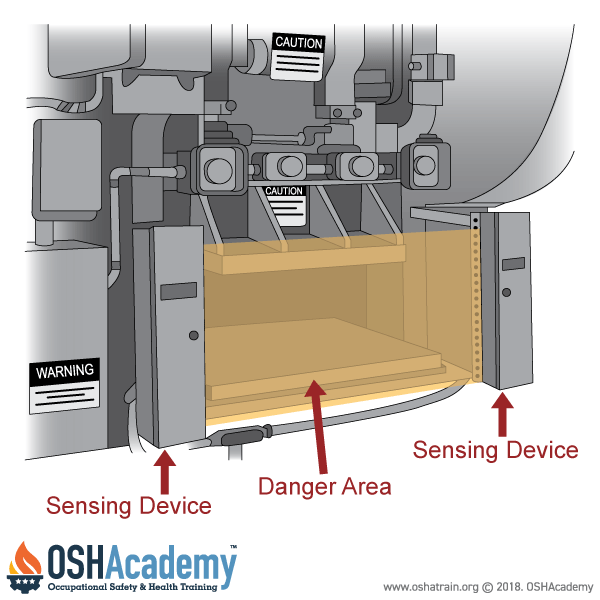Photoelectric Presence-Sensing Devices
A photoelectric (optical) presence-sensing device uses a system of light sources and controls that can interrupt the machine's operating cycle.
Key Features of Photoelectric Presence-Sensing Devices
The key features of a photoelectric presence-sensing device include the following:
- If the light field is broken, the machine stops and will not cycle.
- It must be used only on machines that can be stopped before the worker can reach the danger area.
- The design and placement depend on the time it takes to stop the machine and how fast the operator’s hand can reach from the guard to the danger zone.
Examples
- Light curtains are vertical arrays of infrared light beams that stop the machine when any beam is interrupted.
- Laser scanners that scan an area with laser beams and stop the machine if the beam is broken.
- Optical sensors on press brakes that detect if a hand enters the danger zone and stop the press immediately.
- Safety light barriers on robotic arms that prevent operation if a person crosses into the robot's work area.
- Photoelectric sensors on conveyor systems that stop the conveyor if a worker's hand or body interrupts the light field near dangerous pinch points.
The knowledge and skills that employees must gain when using presence sensing devices are summarized in 1910.217 Subpart O and OSHA Publication 2254, Training Requirements in OSHA Standards .
| Safeguarding Action | Advantages | Limitations |
|
Machine will not start cycling when the light field is interrupted When the light field is broken by any part of the operator's body during the cycling process, immediate machine braking is activated |
Can allow freer movement for operator Simplicity of use Used by multiple operators Provide passerby protection No adjustment required |
Does not protect against mechanical failure Limited to machines that can be stopped |
Knowledge Check Choose the best answer for the question.
3-2. What happens when the light field is broken while using a photoelectric presence-sensing device?
You forgot to answer the question!

